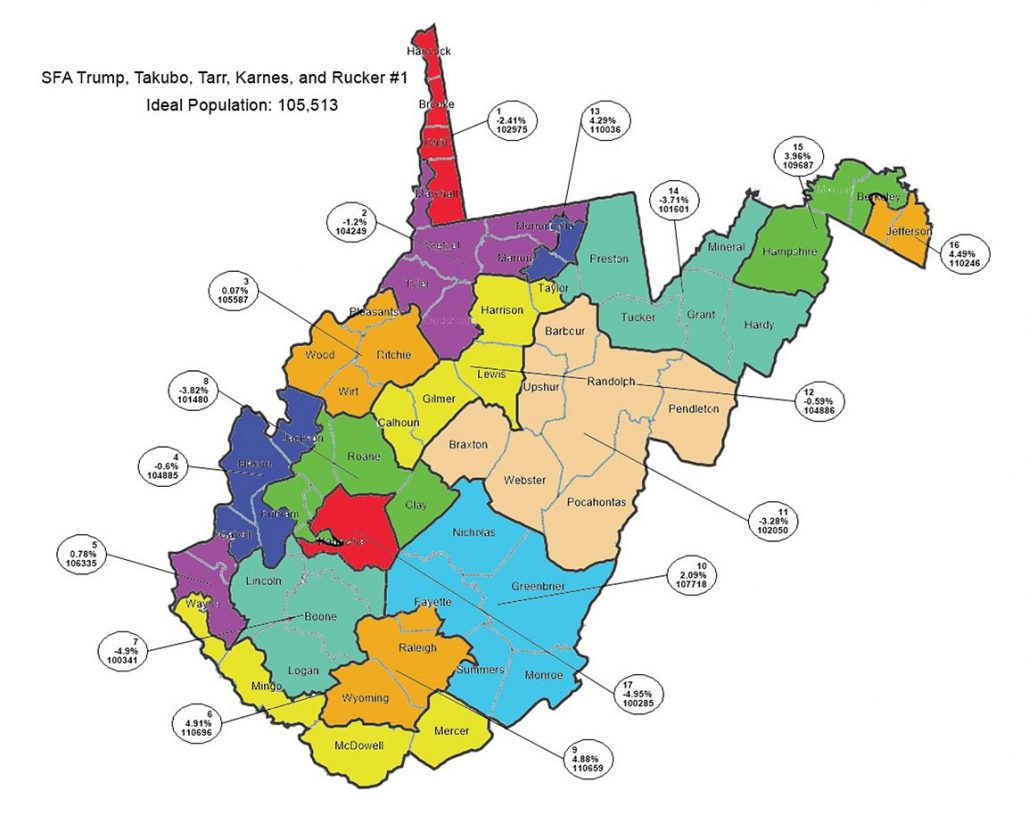West Virginia Senate approves new senatorial district map after delays
Bill drawing new borders for the 17 state senatorial districts finally passed

Contributed MAP — The Trump, Takubo, Tarr, Karnes and Rucker map was approved under Senate Bill 3034 by the West Virginia Senate Tuesday afternoon, delineating new boundaries for the state’s 17 Senate districts.
CHARLESTON — The fifth time was the charm Tuesday, as the West Virginia Senate passed a bill drawing new borders for the 17 state senatorial districts after days of delays and internal disagreements on maps.
Senate Bill 3034, dividing the state into senatorial districts, passed 31-2 with one senator absent after two factions of Senate Republicans came to an agreement on a map amendment Tuesday afternoon.
The Legislature meets every 10 years to redraw congressional, delegate and senatorial districts based on updated U.S. Census numbers.
West Virginia’s population dropped from 1,852,994 residents to 1,793,716 residents in 2020, resulting in the need to draw 17 senatorial districts with as close to 105,513 residents as possible while remaining compact and maintaining communities of interest. While it is encouraged to consider county boundaries when drawing the district, at least four county splits are required to keep districts as equal in population as possible.
An amendment was offered to SB 3034 on Tuesday afternoon by Senate Redistricting Committee Chairman Charles Trump, R-Morgan.
The amendment was a compromise between moderate Republicans led by Trump and Senate Majority Leader Tom Takubo, R-Kanawha and more conservative members of the majority caucus, led by state senators Robert Karnes, R-Randolph, and Eric Tarr, R-Putnam.
The amendment was a hybrid of an amendment offered to SB 3034 Monday by state Sen. Patricia Rucker, R-Jefferson, and several conservative members of the majority caucus; and an amendment to that amendment made by Takubo and Trump. The Takubo/Trump amendment to the Rucker amendment was adopted in a 17-16 vote, but the Rucker amendment failed 14-19, putting the bill back to the plan recommended for passage Oct. 11 by the Senate Redistricting Committee.
Trump, explaining the new compromise amendment during a floor speech Tuesday, said it was a good combination of Monday’s two amendments.
“I would characterize this as a synthesis of the maps that we had up on the floor for consideration (Monday),” Trump said. “This amendment tries to reconcile and harmonize some of the issues that were points of contention, and I think it does a good job of that.”
While the original Senate Redistricting Committee plan only divided seven counties and the Rucker amendment divided 13 counties, the compromise amendment offered Tuesday broke up 11 counties, including counties typically not broken up, such as Cabell, Jackson, Fayette and Taylor counties.
Trump said even with these splits, the map approved Tuesday complies with the constitutional one-man-one-vote rule, the districts are within the parameters for population deviation and the districts in the map have a higher compactness score than the districts drawn by the Democratic-controlled state Senate 10 years ago.
“It meets the constitutional requirements imposed upon us,” Trump said. “I dare say I’m pretty sure there isn’t a single person in this room who would say ‘this is my perfect plan. This is my dream plan.’ This is the product of conversations and compromises and hard work over a long period of time by a great number of people.”
The only two nay votes to the amendment and to SB 3034 itself were state Senators Glenn Jeffries and Richard Lindsay, both Democrats. Jeffries and Lindsay represent the 8th Senatorial District of northern Kanawha County and eastern Putnam County. SB 3034 shrinks the Kanawha and Putnam portions and combines them with Roane and Clay counties along with southeastern Jackson County.
“I believe this amendment is a disservice to the people of Kanawha County,” Lindsay said. “It is the one county that is split three ways whereas according to the original (bill) … Kanawha County was split two ways.”
The Senate Redistricting Committee approved a map on Oct. 11 at the start of the special session for redistricting, but talk surfaced that day of an alternative proposal being shopped around by some members of the Republican caucus.
The plan was uploaded to the Senate Redistricting Committee’s website last Wednesday night. The bill was laid over Wednesday, Thursday and Friday as Republicans fought behind closed doors over the two competing proposals.
After Monday’s amendment votes, the bill was laid over again until Tuesday’s final vote.
Meanwhile, the House of Delegates completed working on its redistricting last Wednesday and the Senate and House came to an agreement on a congressional redistricting plan Friday that took the state down from three districts to two north and south districts.
The House adjourned last Friday subject to the call of House Speaker Roger Hanshaw, R-Clay. The House will still need to hold a vote to approve SB 3034, though traditionally each chamber does not interfere with each other’s redistricting bills.
(Adams can be contacted at sadams@newsandsentinel.com)

